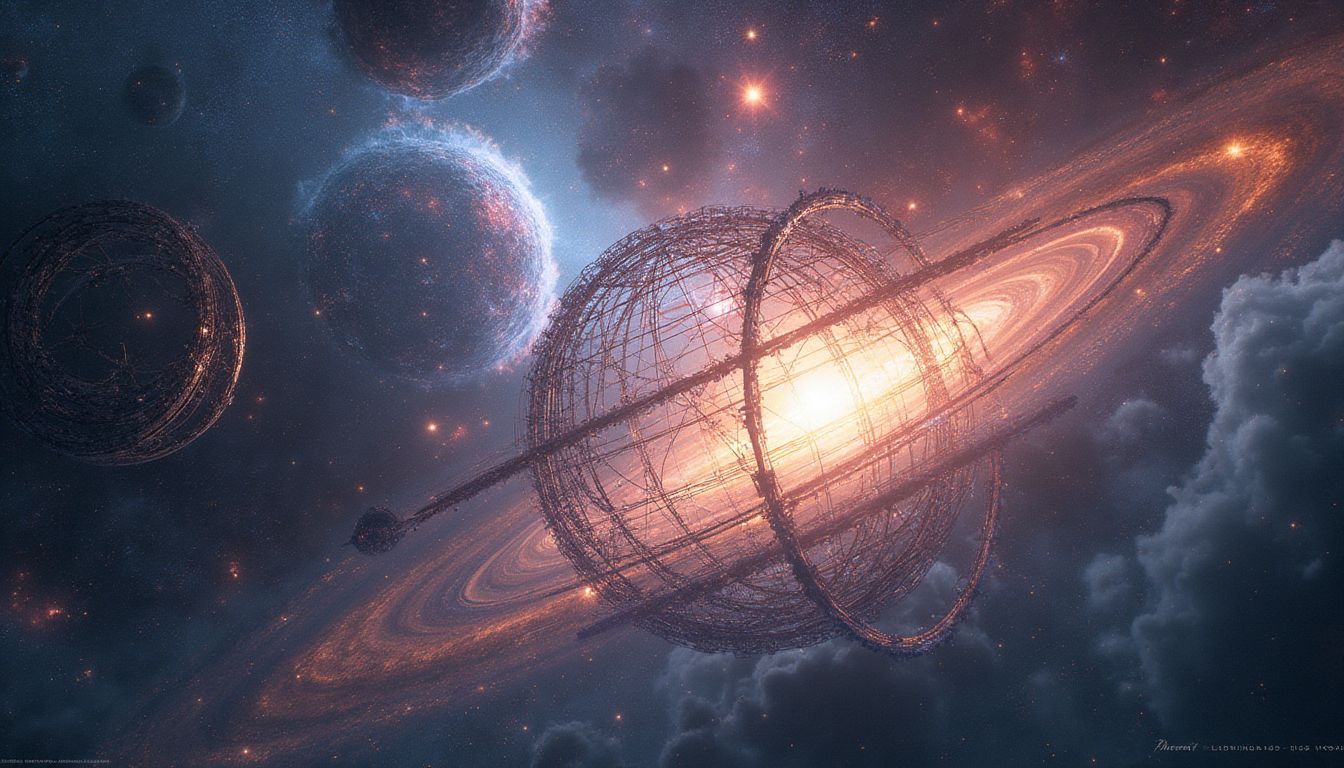Introduction: Harnessing Cosmic Power
"The unexamined life is not worth living." - Socrates.
What if every star in the galaxy could be our power source? What if the greatest energy project ever imagined could transform our cosmic destiny?
Every so often, the universe offers a glimpse into the possibilities of human potential, and today, the concept of harvesting energy from entire galaxies dares us to dream bigger. Could the Dyson Sphere, a once theoretical megastructure, actually encircle an entire galaxy? With advances in artificial intelligence and deep space engineering, this may be closer than many believe.
Visionaries like Freeman Dyson, who first proposed this idea in the 1960s, always stirred imaginations. He inspired a new lineage of astrophysicists and technologists. As AI progresses under the guidance of leaders such as Sam Altman at OpenAI and Mark Zuckerberg at Meta, thoughts of building structures that orbit entire stars—and potentially entire galaxies—move from sheer fantasy to conceivable future.
Let's not kid ourselves; this isn't child’s play. Constructing a Dyson Sphere around even one star poses immense challenges. Yet, as Karl Marx once proposed, societal progress depends on overcoming hurdles, shifting from ambitious ideology to impactful action.
Advanced AI systems, also known as Artificial Superintelligence (ASI), have the potential to address complexities in star harnessing which seem insurmountable today. Think subtitles flipping reality—a cosmic ballet where every star becomes a long-lasting beacon for human advancement.
Guided by emergent technologies and fueled by humanity's insatiable curiosity, the journey to create galaxy-sized Dyson Spheres has begun. Trusty scientific voices such as Michio Kaku, acclaimed futurist, invite us to ruminate on galactic engineering's profound implications to kindle inspiration, weaving connections between our distant dreams and everyday challenges.
**Artificial Superintelligence (ASI)** will be key in harnessing the energy of galaxies through Dyson Spheres by integrating AI to design, build, and manage these cosmic structures, using advanced algorithms to address engineering and ethical challenges.
The Concept of Dyson Spheres and Their Evolution
The Origins of the Dyson Sphere Concept
Let's blast off on a journey straight from the visionary vaults of science fiction into the world of cosmic engineering! In 1960, astronomer Freeman Dyson, with his gigantic imagination, introduced a concept that could light up entire galaxies—the Dyson Sphere. Imagine wrapping a whole star in a humongous structure to capture its energy. Sounds like something out of a superhero comic, right?
Dyson's brainchild wasn’t merely the stuff of legends; it became a pillar of theoretical physics and engineering. The concept fascinated scientists and dreamers alike, akin to a moth to a flame—or perhaps more aptly, like moths to an infinite array of twinkling celestial lights. It suggested harnessing the power of the stars; not in obscure sci-fi terms, but as a concrete solution to humanity's energy problems.
Dyson’s bold suggestion was packaged in the brains of thinkers and scientists, all of whom gathered around this curious orb of energy, pondering how such a monumental project could actually work. Not only did the concept capture imaginations, but it also drew the curiosity of futurists. After all, who doesn’t want to envision a future where cities run on star power? A time when humans have spread their technological tendrils across the stars, fostering possibilities as countless as the Milky Way's own starry expanse.
For many, the Dyson Sphere isn't just about basking under a never-setting sun; it's about mankind's grand leap from an Earth-centric civilization into a cosmic architect of dreams. Much akin to unspooling the very fabric of the universe to weave a tapestry of immense potential—albeit while thinking, "Why wake up to the scent of hot coffee, when one might awaken to a daybreak of stellar brilliance?"
Technological Advancements in Star Harnessing
The road from theory to reality is paved with countless advancements and breakthroughs that have paved our way to potentially constructing these stellar contraptions. Solar power, once the preserve of science enthusiasts, began its journey toward becoming a household staple through the tireless efforts of dreamers and inventors like Alexandre-Edmond Becquerel. Solar panels now gracing rooftops worldwide can trace their lineage back to Becquerel's work in 1839.
Such strides rose further as the 21st century saw leaps in material science, like the evolution and refinement of solar cells and panels. Innovations in nanotechnology play a crucial role in this transformation, promising structures and materials of astounding abilities and strength. Giant molecular constructions could potentially bear the mounting energy demands of future structures spreading into the vast dominion of Dyson's designs.
And that’s not all! Let's not forget that the evolution of nanotechnology has taken a mighty swing at redefining how energy might one day be collected and stored. With microscopic machines that build things and materials that defy traditional science, we start to touch on the tantalizing tapestry of possibilities.
With every passing flurry of scientific exploration comes fresh ingredients to mix into this cosmic recipe. Dare it be said, it's as if the universe is setting the table for mankind's ultimate starlit banquet: a feast of inexhaustible power. As our technological toolkit has expanded, suddenly, the vastness of a Dyson Sphere feels a tad more believable. Like a cosmic Lego set, waiting for humanity to start clicking pieces into place, layer upon celestial layer.
Theoretical Designs and Schematics for Galactic Dyson Spheres
Designing such grand cosmic structures is no small feat! The genius minds inspired by Dyson's initial vision have since brainstormed countless versions of the original concept, building elaborate blueprints like pieces of an intricate space-time jigsaw puzzle.
The Dyson Swarm is one such innovation, a veritable army of smaller units encircling their stellar quarry. Imagine a solar fleet, each component parked just in the right spot to collectively drink in the star’s energy, much like ants circling a sugar pile. Each unit moves autonomously, guided by artificial intelligence, ensuring optimal coverage and reactive capabilities.
Then there are Dyson Rings, which take the form of tightly orchestrated loops around their star. These rings boast stability and automation, forming a simpler, albeit less energy-intensive, structure. But imagine this: the rings, in their silent dance around the sun, become bridges leading humanity onto the next stage of celestial construction. It's almost poetic—the gears of the universe turning in time to a cosmic crescendo.
Above all, whether examining Dyson Swarms, Rings, or designs not even yet conceived, what's always mesmerizing is our pursuit of rendering these audacious ideas into the very fabric of our cosmic neighborhood.
So, why should we be interested in manufacturing gargantuan structures around stars in the galaxy? Perhaps it’s the thrill of innovation or the siren call of monumental energy sources that promise to exceed all imagination. Whatever the motivation, Dyson’s concepts propel us toward a luminous future sparked by stars—a future where humanity might transcend its Earthly roots, reaching into the cosmic canvas painted by sci-fi tales of yore.
The Engineering Challenges of Building Dyson Spheres
Structural Integrity and Material Requirements
Building a Dyson Sphere isn't like putting together a giant Lego set. Imagine trying to make a house out of playing cards that stands up to tornado-level winds. The Dyson Sphere needs unfathomable strength and durability. The materials? Well, steel or concrete wouldn't cut it. In fact, some might say, "We need something from Superman's toolbox." Enter graphene, a wonder material that's not only incredibly light but insanely strong. A single layer of graphene is stronger than the best steel, transparent, and conducts electricity like nobody's business. To imagine it wrapping around stars, though, is like picturing a giant spider web in space, all created with this miraculous material.
However, graphene is still in its developmental stages for such massive reconstruction. If you think about what it would take, the quantity needed to cover an entire star, let alone a galaxy, makes your brain spin. So, where do we get all this graphene? The planet-sized manufacturing plants would either have to be built in space or on distant worlds with fewer environmental regulations—talk about off-planet outsourcing.
To build something this enormous, we also need a perfect balance in design. Think of a massive balloon, pumped just right so it doesn't burst or deflate. But this balloon is in space! Factors such as temperature variations and cosmic radiation can weaken materials over vast timespans. Engineers will need to consider all this, creating designs that allow the structure to 'breathe' and expand. Or perhaps segments can fold up like a cosmic accordion to flexibly adapt to its celestial environment.
Power Generation and Resource Management
Imagine having the Sun on speed dial for all your energy needs. With a Dyson Sphere encapsulating it, we're harnessing mind-blowing amounts of energy. But just like when your phone keeps running out of juice, how this power is captured, stored, and distributed is key. We need to plug in smart systems, much like a power grid on steroids—or would that be on solar-roids?
For this, we can lean into artificial intelligence to optimize everything. After all, managing that much energy without A.I would be like trying to control a herd of cats on caffeine. Algorithms can help in understanding peak usage periods and storage logistics. Think of it as having a cosmic butler always knowing when to serve and when to conserve. The ability to harness and efficiently use this energy could expand human potential by leaps and bounds. Just imagine powering entire cities in a blink, or fueling interstellar travel like it's a Sunday drive.
Resource management is another kettle of cosmic fish altogether. Creating a sustainable model is crucial. It's not just about extracting resources but also replenishing them. Scientists might explore new routes like asteroid mining, reminiscent of an interstellar gold rush. With this, they could get the necessary raw materials while tightroping the delicate balance of ecological impact. Because, let's not forget, turning asteroids into sleek energy cubes requires a careful dance of science and stewardship.
Managing Orbital Dynamics and Environmental Factors
If you've ever juggled, you know keeping a few balls in motion is tricky. Now, try adding gravity and solar winds into the mix, except these 'balls' are as massive as planets. This is one of the significant challenges in maintaining Dyson Sphere's stability. Its gravitational pull, combined with the star's gravity, could create 'cosmic chaos,' so to speak. It necessitates careful planning in orbital dynamics to ensure it doesn't collapse like a cosmic soufflé.
Orbital dynamics involve the balance of centrifugal forces—think of spinning a bucket of water and not spilling a drop—to keep the Dyson Sphere in place around its star. Scientists must account for thousands of variables, including gravitational influences from nearby cosmic bodies, the star's fluctuating energy output, and hazards like solar flares or cosmic debris. It's essentially a stellar dance with no room for two-left-footed maneuvers.
Environmental factors also pose substantial challenges. Space is like an invisible minefield, with radiation storms and micro-meteorites constantly threatening structural integrity. Fortunately, advancements in material technology could offer modular designs that self-repair or replace damaged sections autonomously. If they execute their cosmic dance correctly, these mammoth structures will weather any storm with elegance and grace. So, as we continue making bold strides in the stellar engineering department, these challenges become opportunities to redefine human limits and turn celestial dreams into tangible realities.
The Role of Artificial Superintelligence in Constructing Dyson Spheres
Strategic Planning and Resource Allocation
When it comes to building something as mind-boggling as a Dyson sphere, you can't just wing it like putting together a backyard shed. Instead, this is where artificial superintelligence (ASI) truly shines like a proverbial spotlight. Imagine ASI as the ultimate project manager, able to collect and analyze astronomical data faster than your favorite search engine—looking at you, Google.
One of the first roles of ASI is to create master blueprints for the entire project. These blueprints will include geological maps, design specifications, and even contingency plans for surprise asteroid visits. Why rely on ASI for this? Well, if you've ever tried assembling IKEA furniture using a half-translated manual, you'll appreciate having a superintelligent guide.
Beyond blueprints, ASI excels at resource allocation across the vastness of space. Essentially, it's like having Amazon's logistical expertise, but scaled up to manage resources spread over light-years. Imagine Mars contributing iron and the asteroid belt sending over carbon—all managed remotely by ASI. Sounds like a cosmic orchestra, doesn't it?
Autonomous Construction and Maintenance Robotics
Once ASI has laid out the plans, it's time for the robots to shine—or at least to start welding. Enter the realm of autonomous construction robotics, which are like the busy bees of outer space. Using cutting-edge technologies stemming from today's advancements like Boston Dynamics and their dynamic robots, these mechanical marvels will build and maintain the overarching structure of the Dyson sphere.
Picture a swarm of diligent, metallic ants, each with a specific task dictated by ASI down to an atom's breadth. These bots will have the ability to work cohesively—unlike your toddler with a set of building blocks. Maintenance is no small feat either. These robots need to perform constant checks for micro-meteoroid damage or any structural hiccups. It's like having an army of Roomba vacuums, only these don’t just clean—they fix stuff. The cherry on top is that these robotic workers keep working without complaint, coffee breaks, or requests for ergonomic keyboards.
Today, autonomous bots already paint a promising picture. Just look at Tesla, which has reshaped our views on autonomous driving. Now, imagine that same technological rigor applied to building in the vast unknown of space!
Advanced AI Algorithms for Problem-Solving in Complex Systems
While robots work tirelessly, ASI keeps a watchful eye on proceedings, continuously analyzing data and resolving problems even as they arise. We need some serious number crunching to pull this off. This is the time for advanced AI algorithms to take center stage. These super smart brains juggle simulations, mechanical designs, and error predictions. Imagine a smarter version of Dr. Strange from Marvel, calculating not just a few million possibilities but quadrillions, pinpointing the best timeline for building that cosmic marvel!
AI-powered software can proactively address complications. Everything from energy distribution problems to preventing robot collisions is plotted through smart algorithms. Shoutout to machine learning here, constantly getting better just in case Albert, the robotic welder, hits a snag in space.
For inspiration, consider DeepMind, known for beating pros at board games with layers of cunning strategies. Imagine what similar neural networks could do when tasked with interstellar engineering challenges.
In formulating cutting-edge AI algorithms, all scientific knowledge gets flexed, from quantum mechanics to chaos theory. Complicated equations that would give regular scientists nightmares become routine jobs for ASI.
Undeniably, constructing Dyson spheres demands an advanced level of creativity, which ASI provides in abundance. As songs by the Rolling Stones go, "You can't always get what you want," but with ASI, maybe we might just get what we need—and little more.
Potential Societal and Ethical Implications of Galaxy-Wide Dyson Spheres
Energy Distribution and Economic Impact
Imagine a world where energy is limitless—a cosmic candy store where everything is free! With the potential of Dyson spheres, we're staring straight at this dream. But, hold your horses! This energy bonanza could shake things up right down to our wallets.
Think about it. Today, energy is one of the biggest limits to economic growth. In some places, electricity can be as scarce as water in a desert. What happens when that's no longer true? The answer is both exciting and, well, a bit scary.
If energy is free and unlimited, electricity bills could become relics of the past. You could charge up futuristic, electric cars in seconds or power massive supercomputers without breaking a sweat! But then again, those who've been cashing in on energy—like energy companies—may have to reinvent themselves or disappear faster than a soap bubble in the sun.
- Pros:
- Economic growth due to reduced energy costs.
- More resources for social programs due to reallocating funds spent on energy.
- Cons:
- Displacement in the job market, especially in traditional energy sectors.
- Evolving tech may leave behind those unable to adapt.
So, it's a balance. A world of infinite energy means gigantic strides in technology and lifestyle possibilities. With lasers, you could fix potholes from space! But like a seesaw, what's up must eventually come down. It's critical to keep an eye on balance so no one gets catapulted into the new world unprepared. Will we emerge as better stewards of this newfound power? Only time will tell.
The Ethical Considerations of Galactic Scale Engineering
Now, let's tackle the big, cosmic elephant in the room: Should we even do this? Messing with entire galaxies sounds a bit like playing with cosmic LEGO bricks. What's right, and what's wrong when it comes to space construction?
Life on Other Worlds
Imagine if our cosmic tinkering affects life out there. What if we cover a star and accidentally cut off energy to an alien civilization? Yikes! Being space cowboys with our Dyson spheres might not be the best if we stumble over someone else's backyard.
Thinking Big
Is it okay to dabble with celestial bodies, just because we can? Stephen Hawking once said, "With great power comes great responsibility." Well, not quite, but close enough. While exploring the stars, we need to remember we're part of a vast community in the universe.
Our decisions could have ripple effects. Remember why we climbed this giant ladder in the first place. The responsibility is enormous, and our cosmic citizenship should be about thoughtful exploration rather than trying to become cosmic landlords!
| Ethical Considerations | Positive Impacts | Potential Risks |
|---|---|---|
| Interfering with extraterrestrial life | Opens possibilities for collaboration | Accidental harm to unknown civilizations |
| Ownership of celestial bodies | Advanced knowledge of our universe | Cosmic colonization concerns |
Governance and Decision-Making in an ASI-Driven Future
Let's imagine an artificial superintelligence (ASI) steering our cosmic ships. It sounds thrilling but who really gets to call the shots? How do we make sure this doesn't turn into a scene from The Matrix?
Who's in Charge?
Whether we're discussing NASA or some alien galactic councilwormhole yet to be discovered, someone's got to have the last word on how this galactic techo world spins. Is it a single government or a global council? As we reach for the stars, decision-making needs to be as sharp as a laser beam.
Thinking Big
The idea of governance isn't just about rules and regulations, but about camaraderie and cooperation. It's one colossal pinky promise to play nicely in the galaxy sandbox, prioritizing what benefits the cosmos at large.
- Establish clear, universal policies on space exploration.
- Create a global coalition accessible to all space-faring nations.
- Empower ethical boards that include neutral parties.
- Uphold transparency and accountability at all levels.
Ultimately, it's crucial to ensure that the future doesn't belong to just one AI, government, or organization. A cosmic journey this ambitious shouldn't rely on a single script. Let's embrace inclusive dialogue and shared humanity on this ride into the unknown!
Future Visions: Beyond Dyson Spheres and Towards the Engineering of Entire Galaxies
Exploring Other Megastructures Beyond Dyson Spheres
Imagine a world where harnessing the energy of a single star just isn't enough. What if we could create structures that would make even a Dyson Sphere seem quaint? Enter the realm of other megastructures that tickle the imagination of thinkers today. Meet the Alderson Disk, a concept so colossal that it could enclose an entire star system. Picture a flat, thick disc encircling a star like a cosmic revolving floor, supporting life on both sides, complete with oceans, mountains, and its own atmosphere.
But that's not all! There's the Matrioshka Brain, a staggering idea that combines a series of Dyson Spheres nested within each other. Each outer layer is a new shell constructed using advanced materials capable of absorbing energy from the inner layers until it consumes all the star's power. In essence, these structures would serve as a colossal thinking machine covering light-years.
These structures prompt us to question the limits of our imagination and technological growth. They make us ponder the idea that humanity, or any advanced civilization, could command mastery over an entire star system. It's a vision that transcends what we currently know and positions us on the edge of what we might become.
Intergalactic Resource Harvesting and Civilization Development
The universe is rich with resources waiting to be tapped. Think of it as a cosmic treasure trove where everything from raw materials to precious metals is merely floating in vast quantities among the stars. It beckons the bold and the visionary—those willing to take the leap into the proverbial great unknown.
Envision a distant future where intergalactic miners extract elements like tritium, helium-3, or even the elusive gold from meteors and asteroids. Unlimited resources could pave the way for staggering advancements in technology and civilization development, facilitating the next great industrial revolution. Intrigued yet? Here’s what such an endeavor can entail:
- Strategic partnerships with key celestial bodies for raw material extraction.
- Development of orbital infrastructure for processing and refining resources in-situ.
- Advanced transportation networks using space elevators or wormholes for efficient material transfer.
- Implementation of ethical resource management practices to preserve the cosmic environment.
Intergalactic resource harvesting could position civilizations light-years ahead in terms of technological prowess and sustainability. It demands a synthesis of forward-thinking policy-making and groundbreaking advancements, orchestrating a future where we coexist alongside an ever-expanding array of cosmic nations. Does this form of exploration only serve technological advancement, or could it foster a new era of cultural and moral evolution?
The Long-Term Vision: A Type III Civilization
For those enthralled by the grandeur of cosmic engineering and boundless possibilities, the Type III civilization remains the ultimate aspiration. Positioned on the far side of Dr. Kardashev's scale, such a civilization would wield the energy of entire galaxies.
How could humanity take the first strides towards this remarkable feat? The pathway begins with small steps:
- Transitioning to a Type I civilization: Achieve mastery over planetary energy resources, advocating renewable solutions globally.
- Progression to Type II civilization: Harnessing the power of stars through Dyson Sphere-like constructs and other megastructures.
- Cultivate interstellar collaboration to standardize resource distribution and technological advancements across galaxies.
- Develop systems for efficient galactic communication, transcending standard radio waves.
- Advancements in bioengineering and technology convergence to enhance interstellar survival and adaptation.
As we gaze into the galaxies, the challenge stretches beyond a testament of technological marvel. It unveils the need for unity and collaboration on a cosmic scale, where exploration leads to shared progress and advancement. Can we unravel the secrets of entire galaxies? More crucially, will we wield that knowledge with wisdom and humility?
Every leap towards a higher level on the Kardashev Scale propels us further into the celestial unknown. What lies beyond the stars is infinitely more than energy and matter. It calls forth the explorers within us, a catalyst for a new dawn in the grand tapestry of the universe.
This vision inspires the unbreakable bond between ambition and reality, encapsulating an era yet discovered. Beyond the megastructures and ideations of fate lies the resonating truth—galaxies are just the beginning.
ASI Solutions: The Methodical Approach to Building Dyson Spheres
Imagine a future where we harness the energy of entire stars, creating Dyson Spheres around them to power our interstellar ambitions. While this idea may sound like science fiction, advancements in Artificial Superintelligence (ASI) could turn this fantasy into reality. The power of ASI lies in its ability to analyze enormous amounts of data and devise complex strategies to accomplish challenges unimaginable to the average human brain. Let’s explore how ASI can play a vital role in constructing Dyson Spheres, breaking down each critical element required for this engineering miracle into actionable steps.
First, we must consider the planning phase. ASI can analyze vast datasets about our solar systems, energy needs, material viability, and potential obstacles we might face. Using advanced algorithms, it will create comprehensive project blueprints, timelines, and resource management plans. The human strengths—innovation, creativity, and ethical considerations—can blend seamlessly with the analytical and repetitive capabilities of ASI, creating a collaborative approach that optimizes both human and machine intelligence.
As we delve into its role, let's first recognize that the learning process of ASI will involve extensive training on existing data from material science, astrophysics, and complex system architectures. This collaborative learning will not only help in building Dyson Spheres but will also set a foundation for future projects beyond our star.
Next, consider the construction phase. Autonomous robots, engineered for precision and resilience, will lend crucial support. Picture robots designed not only to assemble materials but also to analyze ongoing construction processes. They would gather data through sensors embedded in the structures, constantly feeding back to the ASI for real-time adjustments. This ability forms a feedback loop essential for adapting to the challenges that invariably arise during such monumental projects.
Finally, the management of the Dyson Sphere’s energy generation and distribution is where ASI shines brightest. By utilizing machine learning algorithms, ASI can predict patterns in energy usage, ensuring that energy flows efficiently to where it’s needed most. Additionally, real-time data analysis will equip it to identify and tackle unforeseen complications swiftly, showcasing how vital ASI will be in overcoming challenges during construction and operation.
Delving deeper, one vital challenge in constructing Dyson Spheres lies in the vast distances involved. Here, ASI's strategic planning capabilities become invaluable. Recognizing what materials will be required and which resources need to be harvested will allow for optimized logistics that could minimize transportation delays and maximize efficiency. By calculating trajectories and optimal resource allocation based on advanced simulations, ASI could streamline many processes that would otherwise become bottlenecks.
Ultimately, ASI’s capabilities extend beyond construction. As we cultivate this megastructure, societal and ethical implications arise. ASI can help draft governance structures suited for future developments, providing insight into how we manage power distribution and the economic impacts of near-limitless energy. By collaborating with ethicists, engineers, and social scientists, ASI can help craft frameworks that ensure the responsible use of newfound energy resources.
Therefore, as we look toward developing a roadmap of action, let’s begin with a foundation that outlines day-by-day, week-by-week actionable steps for organizations and institutions to implement from the onset of the Dyson Sphere project.
Actions Schedule/Roadmap (Day 1 to Year 2)
Day 1: Assemble a multi-disciplinary team comprising astrophysicists, engineers, AI specialists, ethicists, and resource management experts. Launch a forum for public insight and engagement at platforms like [Stanford University](https://www.stanford.edu/) for academic partnerships to encourage youth interest in astrophysics. Day 2: Establish key objectives of the Dyson Sphere construction project and define metrics for success. Create a dedicated public website to share progress and milestones to maintain transparency and encourage public support. Week 1: Conduct an extensive review of existing literature on Dyson Sphere concepts and select a primary design. Collaborate with online hubs like [NASA](https://www.nasa.gov/) to gain insights on current energy efficiency technologies. Week 2: Begin advanced modeling efforts using supercomputers to simulate Dyson Sphere environments. Algorithms from [OpenAI](https://openai.com/) can enhance simulations by incorporating predictive mechanisms to estimate challenges. Week 3: Identify ideal celestial bodies for Dyson Sphere projects. Utilize research from institutions like the [Harvard-Smithsonian Center for Astrophysics](https://www.cfa.harvard.edu/) to analyze the energy output and stability of selected stars. Month 1: Implement training for ASI using existing data on material science and energy harvesting methods. Engage with materials experts from companies like [3M](https://www.3m.com/) for insights into viable construction materials. Month 2: Establish partnerships with autonomous robotics firms, such as [Boston Dynamics](https://www.bostondynamics.com/), for the development of construction robots. Start construction of prototypes focusing on efficiency and adaptability. Month 3: Initiate a prototype design for energy generation and distribution systems. Collaborate with energy companies, such as [Siemens](https://new.siemens.com/), to develop innovative solutions that can be tested in smaller-scale environments. Year 1: Complete detailed designs for the Dyson Sphere prototypes, submitting proposals to space agencies worldwide. Begin securing funding through public engagement campaigns and partnerships with influential tech companies for entrepreneurial support. Year 1.5: Launch a pilot program to simulate energy capture and distribution with the prototypes, facilitating the feedback loop between ASI and robot performance. Year 2: Begin full-scale construction planning based on data gathered and lessons learned from prototype tests. Finalize governance structures incorporating ethical oversight involving representatives from global agencies such as the [United Nations](https://www.un.org/).
This roadmap offers institutions, organizations, and governments a clear path to navigate the complexities of building Dyson Spheres. Establishing multi-disciplinary teams, fostering partnerships with academia and technology companies, and maintaining transparent, public-facing initiatives can ensure collective progress toward this extraordinary goal.
As we reflect on our quest to harness the energy of the cosmos, we must keep our ethical and societal responsibilities at the forefront of our efforts. With ASI guiding us, we have the opportunity not just to build a Dyson Sphere but to pave the way toward a better understanding of our place in the universe and how we can share its resources wisely.
Conclusion: Building Our Cosmic Future
As we gaze up at the night sky, filled with countless twinkling stars, it’s hard not to feel a surge of curiosity and ambition. The notion of constructing Dyson Spheres around entire galaxies is not just a figment of science fiction or an ambitious dream; it represents a profound shift in the very fabric of our civilization. The potential to harness energy on a galactic scale could lead to an era of unprecedented prosperity, untethering humanity from the constraints of our current energy systems and redefining our connections to the cosmos.
However, the journey to creating these astronomical structures is laden with challenges—both engineering and ethical. We must think critically about the materials we’ll need, from advanced substances like graphene to entirely new technologies we have yet to invent. Solutions will require an understanding of orbital dynamics, resource management, and power generation systems that challenge our current understanding of physics.
Moreover, the emergence of Artificial Superintelligence (ASI) will play a pivotal role in realizing these ambitious constructs. With its unparalleled ability to process vast swathes of data, ASI could help navigate the complexities of building and maintaining these gigantic energy harnessing megastructures. Automated construction robots, guided by innovative AI solutions, could work tirelessly to engineer these structures while simultaneously adapting to unforeseen challenges.
Yet, as we march toward this celestial engineering revolution, we must also confront important societal implications. How will unlimited energy reshape economies? What ethical dilemmas arise from manipulating celestial bodies and ecosystems? These questions demand our attention, as the choices we make today will ripple through the fabric of our society for generations to come.
In summary, the vision of Dyson Spheres surrounding galaxies is both enthralling and daunting. It compels us to dream big while staying grounded in ethical responsibility. The age of the stars may be upon us sooner than we expect, and it is up to us to pave the way with foresight, wisdom, and steadfast resolve. As we continue to explore the universe around us, let us not forget the impact our decisions today will have on the cosmic future we will leave for the generations yet to come.
FAQ
1. What is a Dyson Sphere?
A Dyson Sphere is a big, imaginary structure that could wrap around a star. The idea is to capture the star's energy. It was first proposed by a scientist named Freeman Dyson. He thought about it in the 1960s, and it's now a popular topic in science and science fiction.
2. Why do we want to build Dyson Spheres?
Building Dyson Spheres could give us an enormous amount of energy. Stars produce more energy in a single second than humans use in a million years! With nearly unlimited energy, we could power entire planets, advance technology, and improve our quality of life.
3. What are the different types of Dyson Structures?
1. **Dyson Swarm:** A collection of satellites orbiting a star to capture its energy.
2. **Dyson Ring:** A single ring of satellites around a star.
3. **Dyson Shell:** A solid shell around a star (theoretical and very challenging to build).
4. **Dyson Bubble:** A lighter structure using solar sails to capture energy.
All these designs aim to harvest energy differently, depending on technology and materials.
4. What challenges do we face in building them?
Building a Dyson Sphere isn't easy! We need to tackle a few big problems:
- Material Requirements: We'll need super-strong materials that can withstand space.
- Energy Management: Creating and using all that energy will need smart systems.
- Orbital Dynamics: We must ensure the structure stays in place and doesn't collide with space debris.
5. How does artificial superintelligence (ASI) help?
ASI can help plan everything. Think of it like having a perfect project manager that never runs out of energy! It can:
- Design blueprints for Dyson Spheres.
- Control robots to build and maintain them.
- Use advanced algorithms to solve complex problems during construction.
6. What are the ethical implications of building Dyson Spheres?
Building a Dyson Sphere may come with ethical concerns:
- Are we harming other forms of life by manipulating space?
- How do we ensure responsible use of the energy we capture?
- Should we govern ourselves differently when we have such powerful technology?
7. What is a Type III Civilization?
A Type III Civilization is a very advanced civilization that can harness energy on a galactic scale. It appears on the Kardashev Scale, which measures how advanced a civilization is based on energy consumption. Achieving this status would be a huge leap for us as a species!
8. How long would it take to build a Dyson Sphere?
We don’t really know for sure! Building a Dyson Sphere could take hundreds or even thousands of years. It depends on our technology, resources, and how well we work together as a society to achieve this goal.
9. Can we really build a Dyson Sphere?
While there are significant challenges, researchers are continually making advances in fields like material science, energy engineering, and robotics. So, while it might seem like a far-off dream now, with persistence and creativity, we could tackle the challenge of building a Dyson Sphere!
10. Where can I learn more about Dyson Spheres?
You can read articles, watch videos, or even follow scientists and space organizations on social media platforms. Some great sources are NASA's website and Space.com. They often have the latest news and research on space and energy.
Disclaimer: This article may contain affiliate links. If you click on these links and make a purchase, we may receive a commission at no additional cost to you. Our recommendations and reviews are always independent and objective, aiming to provide you with the best information and resources.
Get Exclusive Stories, Photos, Art & Offers - Subscribe Today!


























Post Comment
You must be logged in to post a comment.